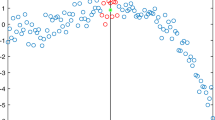Abstract
We consider the problem of interpolating a surface based on sparse data such as individual points or level lines. We derive interpolators satisfying a list of desirable properties with an emphasis on preserving the geometry and characteristic features of the contours while ensuring smoothness across level lines. We propose an anisotropic third-order model and an efficient method to adaptively estimate both the surface and the anisotropy. Our experiments show that the approach outperforms AMLE and higher-order total variation methods qualitatively and quantitatively on real-world digital elevation data.
Access this chapter
Tax calculation will be finalised at checkout
Purchases are for personal use only
Preview
Unable to display preview. Download preview PDF.
Similar content being viewed by others
References
Almansa, A.: échantillonnage, interpolation et détection. applications en imagerie satellitaire. Technical report, ENS Cachan (2002)
Almansa, A., Cao, F., Gousseau, Y., Rouge, B.: Interpolation of digital elevation models using AMLE and related methods. Geoscience and Remote Sensing 40, 314–325 (2002)
Alvarez, L., Guichard, F., Lions, P.L., Morel, J.M.: Axioms and fundamental equations of image processing. Arch. Rational Mech. 123, 199–257 (1993)
Ambrosio, L., Fusco, N., Pallara, D.: Functions of Bounded Variation and Free Discontinuity Problems. Clarendon Press (2000)
Carr, J.C., Fright, W.R., Beatson, R.K.: Surface interpolation with radial basis functions for medical imaging. Trans. Med. Imaging 16(1), 96–107 (1997)
Caselles, V., Morel, J.-M., Sbert, C.: An axiomatic approach to image interpolation. Trans. Image Proc. 7(3), 376–386 (1998)
Cressie, N.: Statistics for Spatial Data. Wiley, New York (1993)
Duchon, J.: Interpolation des fonctions de deux variables suivant le principe de la flexion des plaques minces. R.A.I.R.O. Anal. Numér. 10, 5–12 (1976)
Franke, R.: Scattered data interpolation: Test of some methods. Math. Comput. 38, 181–200 (1982)
Gesch, D., Evans, G., Mauck, J., Hutchinson, J., Carswell Jr., W.J.: The national map – elevation. U.S. Geological Survey Fact Sheet 3053 (2009)
Journel, A.G., Huijbregts, C.J.: Mining Geostatistics. Academic (1978)
Masnou, S., Morel, J.: Level lines based disocclusion. In: 5th IEEE Int’l Conf. on Image Processing, Chicago, IL, October 4-7, pp. 259–263 (1998)
Matheron, G.: La théorie des variables régionalisées, et ses applications. Technical Report 5, Les Cahiers du Centre de Morphol. Math. de Fontainebleau (1971)
Meinguet, J.: Surface Spline Interpolation: Basic Theory and Computational Aspects. In: Approximation Theory and Spline Functions, Dordrecht, Holland, pp. 124–142 (1984)
Meyer, T.: Coastal elevation from sparse level curves. Summer project under the guidance of T. Wittman, A. Bertozzi, and A. Chen, UCLA (2011)
Meyers, D., Skinner, S., Sloan, K.: Surfaces from contours. Trans. on Graphics 11(3), 228–258 (1992)
Mitas, L., Mitasova, H.: Spatial Interpolation. Wiley (1999)
Savin, O.: C 1 regularity for infinity harmonic functions in two dimensions. Arch. Ration. Mech. Anal. 176(3), 351–361 (2005)
Soille, P.: Spatial distributions from contour lines: An efficient method based on distance transformations. J. Vis. Commun. Image Represent. 2(2), 138–150 (1991)
Soille, P.: Generalized Geodesic Distances Applied to Interpolation and Shape Description. In: Mathematical Morphology and its Applications to Image Processing. Kluwer (1994)
Stein, M.L.: Interpolation of Spatial Data: Some Theory for Kriging. Springer (1999)
Author information
Authors and Affiliations
Editor information
Editors and Affiliations
Rights and permissions
Copyright information
© 2013 Springer-Verlag Berlin Heidelberg
About this paper
Cite this paper
Lellmann, J., Morel, JM., Schönlieb, CB. (2013). Anisotropic Third-Order Regularization for Sparse Digital Elevation Models. In: Kuijper, A., Bredies, K., Pock, T., Bischof, H. (eds) Scale Space and Variational Methods in Computer Vision. SSVM 2013. Lecture Notes in Computer Science, vol 7893. Springer, Berlin, Heidelberg. https://doi.org/10.1007/978-3-642-38267-3_14
Download citation
DOI: https://doi.org/10.1007/978-3-642-38267-3_14
Publisher Name: Springer, Berlin, Heidelberg
Print ISBN: 978-3-642-38266-6
Online ISBN: 978-3-642-38267-3
eBook Packages: Computer ScienceComputer Science (R0)




